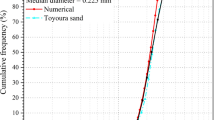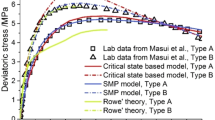Abstract
This study presents a numerical investigation into the mechanical behavior of pore-filling type methane hydrate bearing sediments (MHBS) using the discrete element method. Based on the available experimental data of methane hydrate (MH) samples, MH is modeled as strong bonded clusters. A series of drained triaxial compression tests are simulated and the results show that for the pore-filling type MHBS with MH saturation from 5% to 20%, a higher MH saturation induces a slightly higher shear strength and slightly larger dilatancy. The inclination of the critical state line on the q − p′ plane increases when MH saturation increases. In addition, the evolution rule of deviator fabrics of the strong contact is similar to that of stress ratio q/p′-axial strain.
Access provided by CONRICYT-eBooks. Download conference paper PDF
Similar content being viewed by others
Keywords
1 Introduction
Methane hydrate (MH) is regarded as a new energy resource to alleviate current and future energy needs [1, 2]. MHs usually form in deep seabeds and permafrost regions where MHs can remain stable and can enhance the strength of the host sediments [3]. However, human interventions may give rise to dissociation of MHs, which may further lead to large marine landslide and other hazards such as instability of submarine pipeline and drilling platform. Therefore, it is crucial to study the mechanical properties of methane hydrate bearing sediments (MHBS) for submarine disaster prevention and MH exploitation in the future.
Some pioneering works have been carried out to investigate the mechanical properties of MHBS through a number of experimental and numerical studies [4,5,6,7]. It has been revealed that the shear strength, dilation and stiffness of MHBS are influenced by a series of factors such as MH saturation, confining pressure and temperature etc. Typically, the morphology of MH in sandy MHBS controls the mechanical properties of MHBS from microscopic origin and can be categorized into four types, i.e. pore-filling, load-bearing, cementation, and grain-coating [7]. To explore the isolation effect of pore-filling MH on the mechanical properties of MHBS, the discrete element method (DEM) [8] is used in this study to carry out a series of drained triaxial compression tests on MHBS.
2 Numerical Simulation
To generate pore-filling type MHBS, a homogeneous DEM sample with an initial void ratio of 0.84 was generated. The size of the DEM sample is 4.322 × 4.322 × 8.644 mm3. After that, MH particles are generated within the scope of a sphere with radius of Ra, and then cemented together as a whole, forming a cluster of MH. A cluster consists n = 60 small MH particles with radius of r = 0.024 mm. The total number of cluster N in the MHBS sample with hydrate saturation SMH is decided by:
where V is the volume of the MHBS sample and ea = 0.82 is the void ratio of MH cluster. Note that N sphere particles with radius Ra were firstly generated in the pore of soil sample, subsequently, 60 small particles were generated within the scope of large sphere, which was deleted after small particles were generated. The small particles within each scope were bonded together by the parallel bond model to form a cluster.
After the MHBS sample was generated, drained triaxial compression tests were performed with different effective confining pressures and hydrate saturations.
3 Results
Figure 1 illustrates the stress-strain and volumetric responses of MHBS samples under effective confining pressure of 2 MPa. Figure 1(a) shows that the deviator stress and elastic modulus of MHBS gradually increase with SMH. Figure 1(b) shows that a larger SMH induces a slightly higher dilatancy.
Figure 2 illustrates the critical state lines of MHBS with different SMH on the q − p′ plane. It can be observed that the inclination of the critical state line slightly increases with the increase of SMH.
Figure 3 presents relations between the stress ratio q/p′, deviator fabrics of the strong contact \( F_{11}^{\text{s}} - F_{33}^{\text{s}} \) and axial strain. The unit normal vector for the strong contacts is described by Kuhn [9]:
where Nc is the number of contact, \( N_{\text{c}}^{\text{s}} \) is the number of the strong contacts, \( n_{i}^{\text{s}} \) is the component of the unit vector at a strong contact, and d is equal to 3 for 3D.
Figure 3 shows that the evolution rule of deviator fabrics of the strong contact \( F_{11}^{\text{s}} - F_{33}^{\text{s}} \) is similar to that of stress ratio q/p′-axial strain. The macro behavior changes along with the micro response.
4 Conclusions
The DEM simulation can effectively capture the macro-mechanical response of stress–strain and volumetric response of pore-filling type MHBS with different hydrate saturations. As the hydrate saturation increases from 5% to 20%, the strength, elastic modulus and dilatancy of MHBS gradually increase. The evolution rule of deviator fabrics of the strong contact \( F_{11}^{\text{s}} - F_{33}^{\text{s}} \) is similar to that of stress ratio q/p′-axial strain.
References
Collett, T.S., Kuuskraa, V.A.: Hydrates contain vast store of world gas resources. Oil Gas J. 96(19), 90–95 (1998)
Kvenvolden, K.A.: Methane hydrate—a major reservoir of carbon in the shallow geosphere? Chem. Geol. 71(1–3), 41–51 (1988)
Waite, W.F., et al.: Physical properties of hydrate-bearing sediments. Rev. Geophys. 47, 465–484 (2009)
Masui, A., Haneda, H., Ogata, Y., Aoki, K.: Effects on methane hydrate formation on shear strength of synthetic methane hydrate sediments. In: Proceedings of the 15th international offshore and polar engineering conference, pp. 364–369. International Society of Offshore and Polar Engineers, Seoul (2005)
Hyodo, M., Yoneda, J., Yoshimoto, N., Nakata, Y.: Mechanical and dissociation properties of methane hydrate-bearing sand in deep seabed. Soils Found. 53, 299–314 (2013)
Yu, Y., Cheng, Y.P., Xu, X., Soga, K.: Discrete element modelling of methane hydrate soil sediments using elongated soil particles. Comput. Geotech. 80, 397–409 (2016)
Shen, Z.F., Jiang, M.J.: DEM simulation of bonded granular material. Part II: extension to grain-coating type methane hydrate bearing sand. Comput. Geotech. 75, 225–243 (2016)
Cundall, P.A., Strack, O.D.L.: A discrete numerical model for granular assemblies. Géotechnique 29(1), 47–65 (1979)
Kuhn, M.R., OVAL and OVALPLOT: Programs for analyzing dense particle assemblies with the discrete element method. http://faculty.up.edu/kuhn/oval/doc/oval_0618.pdf. Accessed 28 Feb 2018
Acknowledgements
This work was funded by the National Natural Science Foundation of China with Nos. 51639008 and 51579178, Major Project of Chinese National Programs for Fundamental Research and Development (973 Program) with No. 2014CB046901. All of these supports are greatly appreciated.
Author information
Authors and Affiliations
Corresponding author
Editor information
Editors and Affiliations
Rights and permissions
Copyright information
© 2018 Springer Nature Switzerland AG
About this paper
Cite this paper
Jiang, M., Liu, J., He, J. (2018). Investigating the Mechanical Behavior of Pore-Filling Type Methane Hydrate Bearing Sediments by the Discrete Element Method. In: Wu, W., Yu, HS. (eds) Proceedings of China-Europe Conference on Geotechnical Engineering. Springer Series in Geomechanics and Geoengineering. Springer, Cham. https://doi.org/10.1007/978-3-319-97112-4_40
Download citation
DOI: https://doi.org/10.1007/978-3-319-97112-4_40
Published:
Publisher Name: Springer, Cham
Print ISBN: 978-3-319-97111-7
Online ISBN: 978-3-319-97112-4
eBook Packages: EngineeringEngineering (R0)







